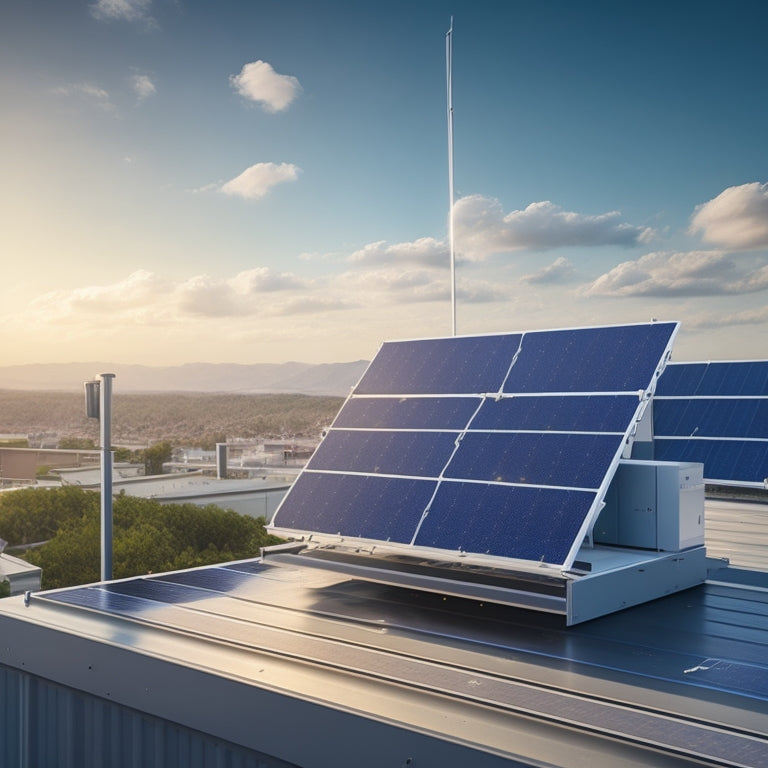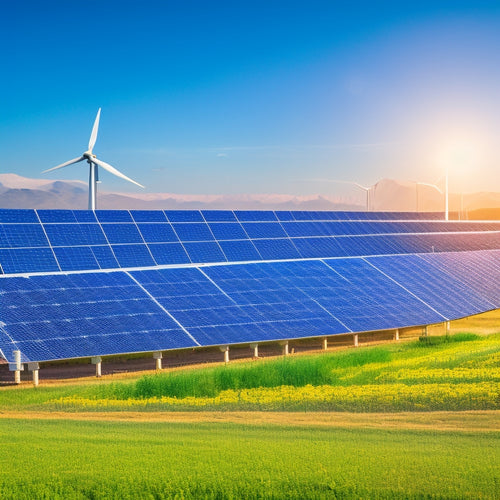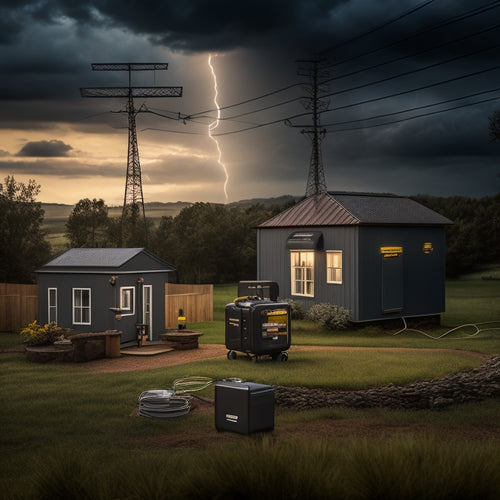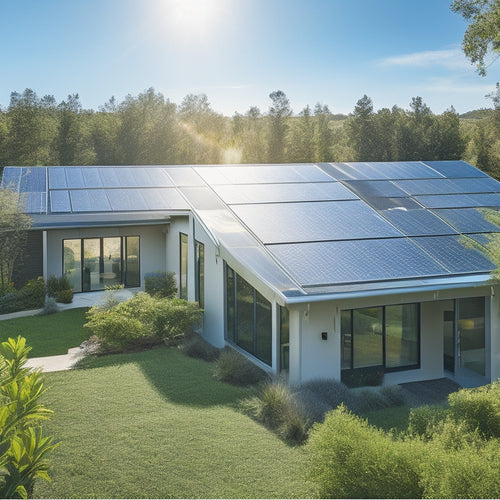
What Inverter for Grid Tie Efficiency?
Share
When selecting an inverter for your grid-tie system, you'll want one with a peak efficiency rating exceeding 98% to minimize energy losses and maximize energy harvesting. Commercial grid-tie inverters typically achieve efficiencies between 95% to 98%, but real-world efficiencies often range from 92% to 96% due to factors like temperature and irradiance. Look for inverters with advanced MPPT algorithms, low standby losses, and high conversion efficiency to prioritize energy output. By understanding the key features and performance metrics, you'll be able to make an informed decision and optimize your grid-tie system's energy production, and exploring further can help you find the perfect fit for your needs.
Overview
- Look for high conversion efficiency ratings, typically between 95% to 98%, to minimize energy losses and maximize energy harvest.
- Advanced MPPT algorithms and low standby losses are essential features for optimal energy harvesting from solar panels.
- Inverters should be able to perform well in various environmental conditions, including high temperatures and partial shading.
- Correct inverter sizing is crucial to ensure operation within the ideal power range and prevent reduced efficiency and increased energy losses.
- Top grid tie inverter brands like SMA, Fronius, and Enphase offer high-efficiency options with advanced features like real-time monitoring.
Inverter Efficiency Ratings Explained
You likely know that inverters are rated for efficiency, but do you understand what these ratings mean and how they're calculated?
Inverter efficiency ratings are a critical factor in determining the overall performance of a grid-tie system. When evaluating inverters, it's crucial to take into account factors like peak efficiency ratings, which typically exceed 98% for maximum energy harvesting, and compliance with industry standards like UL 1741 and IEEE 1547 for safe operation industry standards.
Efficiency standards, such as the California Energy Commission's (CEC) efficiency standards, provide a structure for evaluating inverter technologies. These ratings are typically expressed as a percentage, indicating the amount of DC power converted to usable AC power.
For instance, an inverter with a 98% efficiency rating can convert 98% of the DC power from your solar panels into usable AC power for your home.
When selecting an inverter, look for high efficiency ratings to maximize your energy harvest and minimize energy losses.
Top Grid Tie Inverter Brands
With efficiency ratings in mind, it's time to investigate the top grid tie inverter brands that can help you maximize your energy harvest.
You'll want to focus on brands known for their reliability and performance, with advanced features like real-time monitoring and control, and enhanced monitoring capabilities real-time performance tracking.
Top brands like SMA, Fronius, and Enphase are industry leaders in inverter reliability, ensuring your system operates at peak efficiency.
Additionally, these brands often incorporate advanced inverter technology, including maximum power point tracking and high-efficiency energy conversion, to further optimize energy production.
Schneider Electric and Huawei also offer high-efficiency inverters with advanced features.
When selecting a brand, consider factors like warranty duration, customer support, and compatibility with your solar panel array.
By choosing a reputable brand, you'll minimize downtime and optimize your energy production.
Look for brands with a proven track record of providing high-efficiency inverters that can help you achieve energy independence.
Key Features to Look For
When selecting a grid tie inverter, you'll want to look for key features that maximize your system's performance and efficiency.
You should prioritize inverters with high conversion efficiency, as they minimize energy losses and enhance your energy output.
Moreover, it's crucial to evaluate the inverter's efficiency rating, which typically ranges from 85% to 95% Efficiency Rating, to guarantee peak energy conversion.
Additionally, advanced MPPT algorithms and low standby losses are vital features to make certain your system operates at its best.
High Conversion Efficiency
Grid-tie inverter efficiency hinges on high-power conversion capabilities, which directly impact the overall performance and ROI of a solar panel system.
You need an inverter that can efficiently convert DC power from your solar panels to AC power that's fed into the grid. Look for inverter technology with high conversion efficiency, typically above 98%.
This guarantees that most of the energy generated is converted into usable power, minimizing losses and maximizing your return on investment. A high-efficiency inverter also reduces heat generation, increasing its lifespan and reliability.
When selecting an inverter, prioritize energy conversion efficiency to get the most out of your solar panel system.
Advanced MPPT Algorithm
Most modern grid-tie inverters employ advanced Maximum Power Point Tracking (MPPT) algorithms to optimize energy harvesting from your solar panels.
These algorithms actively track the maximum power point of your solar array, ensuring you get the most out of your system.
The MPPT benefits are twofold: you'll experience increased energy production and improved system reliability.
The algorithm's impact is significant, as it enables your inverter to adapt to changing environmental conditions, such as temperature and irradiance.
With an advanced MPPT algorithm, you can expect faster tracking, higher accuracy, and a more efficient energy conversion process.
When selecting an inverter, look for one with a sophisticated MPPT algorithm to maximize your solar investment and enjoy the freedom of renewable energy.
Low Standby Loss
Efficiency is the cornerstone of a well-designed grid-tie inverter, and low standby loss is a critical aspect of it.
When you're shopping for an inverter, you'll want to look for one that minimizes standby power consumption. This is the energy used by the inverter when it's not generating power, such as at night or during periods of low solar irradiance.
A low standby loss means more energy savings for you. Look for an inverter with a standby power consumption of less than 1 watt. This mightn't seem like a lot, but it can add up to significant energy savings over time.
Efficiency in Different Conditions
You'll want to take into account an inverter's efficiency in various scenarios to guarantee it's optimized for your specific installation.
High temperatures, for instance, can affect an inverter's performance, so it's crucial to evaluate its high-temperature operation.
You'll also want to examine how it handles partial shading effects and low irradiance performance to maximize energy harvest.
High Temperature Operation
Operating at high temperatures is a critical aspect of inverter design, as it directly impacts the system's overall efficiency and reliability. You need to guarantee that your inverter can operate efficiently even in extreme temperatures. This is where thermal management and cooling solutions come into play. Effective thermal management helps to dissipate heat, reducing the risk of overheating and subsequent system failures.
| Inverter Type | Operating Temperature Range |
|---|---|
| Residential Inverter | -20°C to 40°C |
| Commercial Inverter | -10°C to 50°C |
| Industrial Inverter | -20°C to 60°C |
When selecting an inverter, consider the operating temperature range and the cooling solutions employed. Look for inverters with advanced thermal management systems, such as heat sinks or fans, to guarantee reliable operation even in high-temperature environments.
Partial Shading Effects
Partial shading effects occur when some parts of a solar panel array receive less sunlight than others, reducing the overall energy output.
You'll experience this when trees, buildings, or other obstacles cast shadows on your solar panels. As a result, the energy yield of your system decreases.
To mitigate this, you can use inverters with advanced maximum power point tracking (MPPT) capabilities. These inverters can identify the ideal operating point for each string of panels, ensuring that the partially shaded strings don't drag down the entire system's performance.
Low Irradiance Performance
When sunlight is scarce, your solar panel array's energy output takes a hit, making low irradiance performance a vital aspect of grid tie efficiency.
You need an inverter that can maximize energy yield even in low light conditions. A high-efficiency inverter with a low startup voltage can guarantee that your system produces power even when the sun is hiding behind clouds.
Look for an inverter with a low minimum input voltage requirement, as this will enable your system to generate power in low irradiance conditions. This feature is essential for areas with frequent overcast skies or during winter months when sunlight is limited.
Inverter Sizing for Optimal Output
Opt for an inverter that's sized to match your system's maximum power output to maximize energy harvesting.
A correctly sized inverter guarantees that your system operates within its ideal power range, resulting in higher energy yields.
Consider your system's inverter capacity and system compatibility when selecting an inverter.
Oversizing or undersizing can lead to reduced efficiency, increased energy losses, and decreased system reliability.
Ascertain the inverter's capacity aligns with your system's maximum power output to enhance performance.
A well-matched inverter capacity enables your system to operate at its peak, providing you with the freedom to generate clean energy efficiently.
Real-World Efficiency Comparisons
Most commercial grid-tie inverters boast efficiencies ranging from 95% to 98%.
You'll find that real-life scenarios often deviate from these idealized ratings. When evaluating inverter performance, you need to take into account factors like temperature, irradiance, and inverter loading.
In real-world applications, you'll typically see efficiencies ranging from 92% to 96%. To get an accurate depiction of an inverter's performance, you should examine its performance metrics in different scenarios.
For instance, an inverter might achieve 95% efficiency at 25°C, but its efficiency may drop to 92% at 40°C. By examining these metrics, you'll be better equipped to choose an inverter that meets your specific needs and maximizes your energy output in real-life scenarios.
Frequently Asked Questions
Can I Mix and Match Inverters With Different Panel Manufacturers?
You can mix and match inverters with different panel manufacturers, but guarantee inverter compatibility to optimize panel efficiency. Check specifications for compatibility, and consider factors like voltage, current, and connector type to maximize your system's energy output.
Do Grid Tie Inverters Work With Dc-Powered Appliances?
You'll find that most grid-tie inverters aren't designed to power DC appliances directly, as they're optimized for AC output; however, you can use a separate DC-DC converter to enable DC appliance compatibility, but this may compromise inverter efficiency.
Are There Any Inverters With Built-In Energy Storage Capabilities?
You're spoiled for choice with inverters boasting built-in energy storage capabilities, revolutionizing your off-grid dreams! Advanced inverter technology seamlessly integrates energy storage, allowing you to capture and store excess energy for later use, granting you unparalleled freedom and independence.
Can I Install a Grid Tie Inverter Myself or Do I Need a Pro?
You can attempt a DIY installation, but you'll need to verify inverter safety by following manufacturer guidelines and local electrical codes; however, hiring a pro is recommended to avoid potential risks and assure a safe, efficient connection to the grid.
Do Inverters Have Any Certifications for Environmental Sustainability?
You'll be shocked to know that 25% of global emissions come from energy production! When shopping for an inverter, you'll find certifications like Carbon Footprint, EPD, or RoHS, ensuring your choice minimizes environmental impact, giving you freedom from guilt and maximum grid tie efficiency.
Ready to Buy
You've traversed the complex world of grid tie inverters, and now you're left wondering which one will actually deliver on its efficiency promises. Ironically, the most efficient inverter might not be the one with the highest rating, but rather the one that's optimized for your specific installation conditions. Don't get caught in the ratings trap - consider real-world comparisons, inverter sizing, and key features to access the full potential of your solar array.
Related Posts
-

The Role of Battery Monitoring Systems in Renewable Energy
Battery monitoring systems play an essential role in renewable energy by enhancing system longevity and optimizing pe...
-

Key Components of a Reliable Emergency Power Supply System
A reliable emergency power supply system requires several key components. You need proven performance metrics to guar...
-

Installing Metal Solar Roofs for Maximum Energy Efficiency
Installing metal solar roofs can drastically enhance your home's energy efficiency and durability. These roofs withst...


